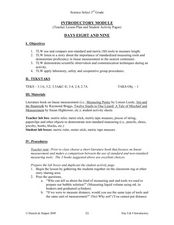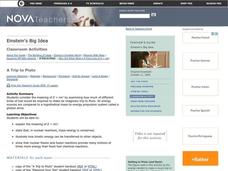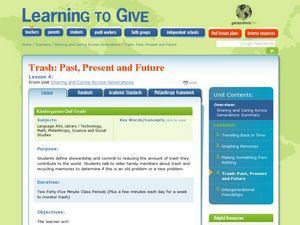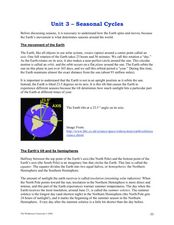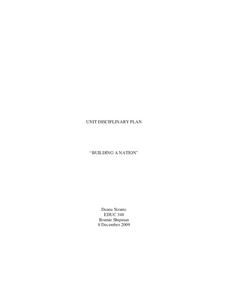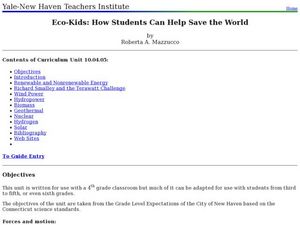Curated OER
Agriculture Counts
Students practice counting. In this early numbers instructional activity, students learn about the beginnings of agriculture and how it ties into math. Students practice counting objects related to agriculture.
Curated OER
Seeds of Wetland Life
Students participate in several activities on seed exploration. In this biology lesson, students classify seeds according to their dispersal method. They explain the different adaptations plant have to disperse their seeds.
Curated OER
Memories to Last: Observing Monuments
Students use scientific observation and inference to examine the Hazen Brigade Monument. In this observation lesson, students review the reasons for building monuments in society. Students then recall monuments they have seen and draw...
Curated OER
Introductory Module
Third graders examine the non-standard method of measurement and compare it to the metric system of measurement. In this introductory module instructional activity, 3rd graders discover the scientific observation. Students also develop...
Curated OER
Einstein's Big Idea
Students investigate the concept of the Einstein's Theory of Relativity while conducting research using the internet and following the outline of the objectives to guide the information search. The lesson includes background information...
Curated OER
Striking a Balance
Students simulate animals in a food chain. In this food chain lesson plan, students are identified as grasshoppers, frogs or hawks. Popcorn is spread across a lawn and students are given baggies (stomachs) and colored sashes to identify...
Curated OER
Blending Butterflies
Students create camouflage butterflies. In this camouflage lesson plan, students read about the different types of camouflage. Each student in the class chooses a spot in the classroom and creates a camouflaged butterfly. They hang up...
Curated OER
Molecular Forces at Work: Creating Soap Bubbles
Students investigate adhesion, cohesion and surface tension. In this molecular forces lesson plan, students observe multiple demonstrations that show surface tension, the attraction of water molecules to each other and the ability of...
Curated OER
Trash: Past, Present and Future
Students explore how much trash they create. In this recycling instructional activity, students define stewardship and conduct an experiment to see how much trash the class produces in a week. At the end of the week the students...
Curated OER
Seasonal cycles
Students understand that the rotation of the Earth is responsible for the seasons. In this seasonal cycles instructional activity, students learn how the rotation of the Earth affects the seasons. Students answer questions about the...
Curated OER
Graphs, Stories, And Games
In this graphs lesson, students read stories and present story situations on a graph. They explore distance and diameter and explain graphs. Students create their own stories to fit graphs.
Curated OER
Using a Sundial
Students examine the use of a sundial to tell apparent time. In this sundial instructional activity, students watch a teacher demonstration using a flashlight to create shadows. They discuss what happens to shadows of different objects...
Curated OER
Building A Nation
Students build their own nation in groups where they create a name, flag, declaration of independence, form of government, mathematical layout, and more. In this nation lesson plan, students also provide a scale drawing of their nation...
Curated OER
Reading Help Wanted Ads
Students explore employment by analyzing the newspaper. In this wanted ads lesson, students identify the importance of job selection and job growth while reading entries in the wanted ads for employment opportunities. Students answer...
Curated OER
Applied Science - Built Environment Lab
Young scholars evaluate trash. For this Science lesson, students collect and weigh trash from their classrooms. Young scholars categorize the trash and the corresponding weights, recording the information on a data sheet.
Curated OER
Climate Mime-it
Young scholars pantomime new climate vocabulary words. In this climate lesson, students go over new vocabulary words and their meanings. Young scholars form groups and pantomime these word's definitions.
Curated OER
What's My Rule for Sorting?
Students view objects sorted by one characteristic and name that characteristic. In this sorting rule lesson, students explore to find a new characteristic and write a description of that rule. In early grades the rule might be supplied.
Curated OER
Eco-Kids: How Students Can Help Save the World
Fourth graders identify the different types of renewable and nonrenewable energy sources. In this ecology instructional activity, 4th graders create models of wind mills and hydropower. They discuss the pros and cons of using alternative...
Curated OER
Is There Room?
Students calculate the area of different polygons. In this geometry instructional activity, students draw shapes using different scale factors. They calculate and make sure there is enough room for te soccer arena through their...
Curated OER
Bird's Eye View Map
Students explore seeing things from a bird's eye view. They listen to the book, "As the Crow Flies," view various objects from eye level views and standing on a chair, create a drawing of an object from both views, and read "Ben's...
Curated OER
The Polymer Schoolhouse
Students study various objects and determine plastic and non-plastic. In this creative instructional activity students get into groups and create a diorama to show the different properties they discovered.
Curated OER
Oil Spills
Third graders examine the San Francisco oil spill and the effects it has had. For this investigative lesson students view a demonstration on oil clean up and how it works. They see how wildlife is rehabilitated, how the oil is cleaned...
Curated OER
Beauty
Students bring an object to school that is of significant sentimental value to them. They arrange the objects in a class display, examine each other's artifacts and discuss the implications and cultural bias of the word 'beauty'.
Curated OER
Beauty
Students share what they think of when they hear the word beautiful. Individually, they bring in an object they believe is beautiful based on its relationship to a person, idea or event. They view each others object and write down...





